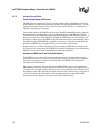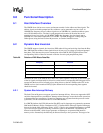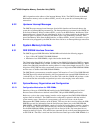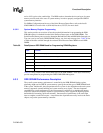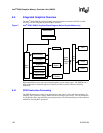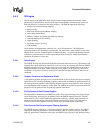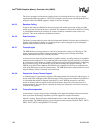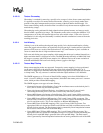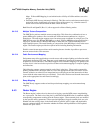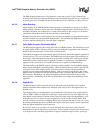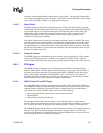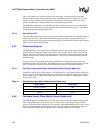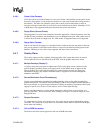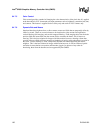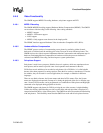
Intel
®
82854 Graphics Memory Controller Hub (GMCH)
130 D15343-003
Maps. Trilinear MIP Mapping is used minimize the visibility of LOD transitions across the
polygon.
• Anisotropic MIP Nearest (Anisotropic filtering): This filter can be used when textured object
pixels map back to significantly non-square regions of the texture (e.g., when the texture is
scaled in one screen direction than the other screen direction).
Both DirectX and OpenGL (Rev.1.1) allow support for all these filtering modes.
6.4.2.13 Multiple Texture Composition
The GMCH also performs multiple texture composition. This allows the combination of two or
greater MIP maps to produce a new one with new LODs and texture attributes in a single or
iterated pass. The setup engine supports up to four texture map coordinates in as single pass. The
GMCH allows up to two Bilinear MIP Maps or a single Trilinear MIP Map to be composited in a
single pass. Greater than two Bilinear MIP Maps or more than one Trilinear MIP Map would
require multiple passes. The actual blending or composition of the MIP Maps is done in the raster
engine. The texture engine provides the required texels including blending information.
Flexible vertex format support allows multi-texturing because it makes it possible to pass more
than one texture in the vertex structure.
6.4.2.14 Cubic Environment Mapping
Environment maps allow applications to render scenes with complex lighting and reflections while
significantly decreasing CPU load. There are several methods to generate environment maps such
as spherical, circular and cubic. The GMCH supports cubic reflection mapping over spherical and
circular since it is the best choice to provide real-time environment mapping for complex lighting
and reflections.
Cubic Mapping supports a texture map for each of the 6 cube faces. These can be generated by
pointing a camera with a 90-degree field-of-view in the appropriate direction. Per-vertex vectors
(normal, reflection or refraction) are interpolated across the polygon and the intersection of these
vectors with the cube texture faces are calculated. Texel values are then read from the intersection
point on the appropriate face and filtered accordingly.
6.4.2.15 Bump Mapping
The GMCH only supports embossed and dot product bump mapping, not environment bump
mapping.
6.4.3 Raster Engine
The Raster engine is where the color data such as fogging, specular RGB, texture map blending,
etc. is processed. The final color of the pixel is calculated and the RGB value is combined with the
corresponding components resulting from the Texture engine. These textured pixels are modified
by the specular and fog parameters. These specular highlighted, fogged, textured pixels are color
blended with the existing values in the frame buffer. In parallel, stencil, alpha, and depth buffer
tests are conducted which will determine whether the Frame and Depth buffers will be updated
with the new pixel values.



